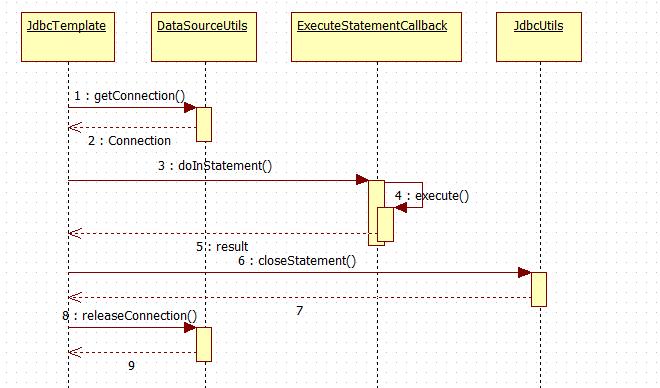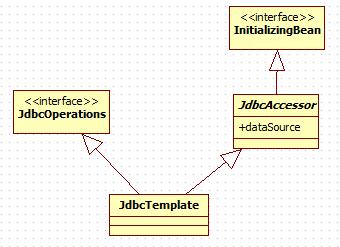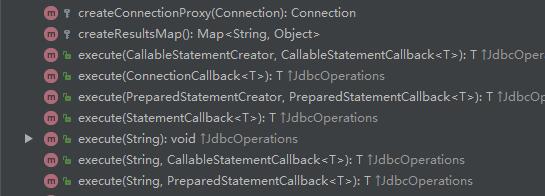回顾JDBC的简单使用
@Test
public void testJDBC(){
String url = "jdbc:mysql://127.0.0.1:3306/test?useUnicode=true&characterEncoding=utf-8";
String username = "root";
String password = "123456";
//1.加载驱动程序
Class.forName("com.mysql.jdbc.Driver");
//2.获取连接
Connection conn = DriverManager.getConnection(url, username, password);
Statement stmt = conn.createStatement();
//3.执行SQL,获取结果
ResultSet rs = stmt.executeQuery("select * from user");
while(rs.next()){
System.out.println("username="+rs.getStriing("username")+" age="+rs.getInt("age"));
}
//关闭资源
rs.close();
stmt.close();
conn.close();
}
execute有很多重载方法,看void execute(final String sql)方法
//执行SQL语句
@Override
public void execute(final String sql) throws DataAccessException {
if (logger.isDebugEnabled()) {
logger.debug("Executing SQL statement [" + sql + "]");
}
//回调类
class ExecuteStatementCallback implements StatementCallback<Object>, SqlProvider {
@Override
public Object doInStatement(Statement stmt) throws SQLException {
stmt.execute(sql);
return null;
}
@Override
public String getSql() {
return sql;
}
}
execute(new ExecuteStatementCallback());
}
//静态处理SQL
@Override
public <T> T execute(StatementCallback<T> action) throws DataAccessException {
Assert.notNull(action, "Callback object must not be null");
//获取数据库连接
Connection con = DataSourceUtils.getConnection(getDataSource());
Statement stmt = null;
try {
Connection conToUse = con;
if (this.nativeJdbcExtractor != null &&
this.nativeJdbcExtractor.isNativeConnectionNecessaryForNativeStatements()) {
conToUse = this.nativeJdbcExtractor.getNativeConnection(con);
}
//创建Statement
stmt = conToUse.createStatement();
applyStatementSettings(stmt);
Statement stmtToUse = stmt;
if (this.nativeJdbcExtractor != null) {
stmtToUse = this.nativeJdbcExtractor.getNativeStatement(stmt);
}
//回调函数
T result = action.doInStatement(stmtToUse);
handleWarnings(stmt);
return result;
}
catch (SQLException ex) {
//释放数据库连接,同时抛出一个Spring转换过的Spring数据库异常
// Release Connection early, to avoid potential connection pool deadlock
// in the case when the exception translator hasn't been initialized yet.
JdbcUtils.closeStatement(stmt);
stmt = null;
DataSourceUtils.releaseConnection(con, getDataSource());
con = null;
throw getExceptionTranslator().translate("StatementCallback", getSql(action), ex);
}
finally {
//释放连接
JdbcUtils.closeStatement(stmt);
DataSourceUtils.releaseConnection(con, getDataSource());
}
}
execute的流程图如下:

@Override
public void query(String sql, PreparedStatementSetter pss, RowCallbackHandler rch) throws DataAccessException {
query(sql, pss, new RowCallbackHandlerResultSetExtractor(rch));
}
@Override
public <T> T query(String sql, PreparedStatementSetter pss, ResultSetExtractor<T> rse) throws DataAccessException {
//创建Statement
return query(new SimplePreparedStatementCreator(sql), pss, rse);
}
public <T> T query(
PreparedStatementCreator psc, final PreparedStatementSetter pss, final ResultSetExtractor<T> rse)
throws DataAccessException {
Assert.notNull(rse, "ResultSetExtractor must not be null");
logger.debug("Executing prepared SQL query");
return execute(psc, new PreparedStatementCallback<T>() {
@Override
public T doInPreparedStatement(PreparedStatement ps) throws SQLException {
ResultSet rs = null;
try {
if (pss != null) {
pss.setValues(ps);
}
//执行查询SQL
rs = ps.executeQuery();
ResultSet rsToUse = rs;
if (nativeJdbcExtractor != null) {
rsToUse = nativeJdbcExtractor.getNativeResultSet(rs);
}
//抽取结果集数据
return rse.extractData(rsToUse);
}
finally {
//关闭结果集
JdbcUtils.closeResultSet(rs);
if (pss instanceof ParameterDisposer) {
((ParameterDisposer) pss).cleanupParameters();
}
}
}
});
}
主要来看一下RowCallbackHandlerResultSetExtractor类
private static class RowCallbackHandlerResultSetExtractor implements ResultSetExtractor<Object> {
private final RowCallbackHandler rch;
public RowCallbackHandlerResultSetExtractor(RowCallbackHandler rch) {
this.rch = rch;
}
@Override
public Object extractData(ResultSet rs) throws SQLException {
//循环获取每一行数据
while (rs.next()) {
this.rch.processRow(rs);
}
return null;
}
}
通过processRow获取每行中的每一列的数据
@Override
public final void processRow(ResultSet rs) throws SQLException {
if (this.rowCount == 0) {
ResultSetMetaData rsmd = rs.getMetaData();
this.columnCount = rsmd.getColumnCount();
this.columnTypes = new int[this.columnCount];
this.columnNames = new String[this.columnCount];
for (int i = 0; i < this.columnCount; i++) {
this.columnTypes[i] = rsmd.getColumnType(i + 1);
this.columnNames[i] = JdbcUtils.lookupColumnName(rsmd, i + 1);
}
// could also get column names
}
//由子类来实现
processRow(rs, this.rowCount++);
}
流程图如下:

public static Connection getConnection(DataSource dataSource) throws CannotGetJdbcConnectionException {
try {
return doGetConnection(dataSource);
}
catch (SQLException ex) {
throw new CannotGetJdbcConnectionException("Could not get JDBC Connection", ex);
}
}
doGetConnection方法
public static Connection doGetConnection(DataSource dataSource) throws SQLException {
Assert.notNull(dataSource, "No DataSource specified");
/*把数据库的Connection放到事务管理中进行管理,这里采用是TransactionSynchronizationManager
中的ThreadLocal变量和线程绑定数据库连接
*/
ConnectionHolder conHolder = (ConnectionHolder) TransactionSynchronizationManager.getResource(dataSource);
if (conHolder != null && (conHolder.hasConnection() || conHolder.isSynchronizedWithTransaction())) {
conHolder.requested();
if (!conHolder.hasConnection()) {
logger.debug("Fetching resumed JDBC Connection from DataSource");
conHolder.setConnection(dataSource.getConnection());
}
return conHolder.getConnection();
}
// Else we either got no holder or an empty thread-bound holder here.
//如果从holder中没有获取连接,那就从数据源中获取连接
logger.debug("Fetching JDBC Connection from DataSource");
Connection con = dataSource.getConnection();
if (TransactionSynchronizationManager.isSynchronizationActive()) {
logger.debug("Registering transaction synchronization for JDBC Connection");
// Use same Connection for further JDBC actions within the transaction.
// Thread-bound object will get removed by synchronization at transaction completion.
ConnectionHolder holderToUse = conHolder;
if (holderToUse == null) {
holderToUse = new ConnectionHolder(con);
}
else {
holderToUse.setConnection(con);
}
holderToUse.requested();
//注册到事务管理器中
TransactionSynchronizationManager.registerSynchronization(
new ConnectionSynchronization(holderToUse, dataSource));
holderToUse.setSynchronizedWithTransaction(true);
if (holderToUse != conHolder) {
TransactionSynchronizationManager.bindResource(dataSource, holderToUse);
}
}
return con;
}
继续来看一下TransactionSynchronizationManager是如何返回ConnectionHolder,最终的方法是在
private static Object doGetResource(Object actualKey) {
Map<Object, Object> map = (Map)resources.get();
if(map == null) {
return null;
} else {
Object value = map.get(actualKey);
if(value instanceof ResourceHolder && ((ResourceHolder)value).isVoid()) {
map.remove(actualKey);
if(map.isEmpty()) {
resources.remove();
}
value = null;
}
return value;
}
}
是从resource中获取一个Map,这个Map中的key就是dataSource,value为ConnectionHolder,而Connection就是包装在里面,resource又是什么类型的?
private static final ThreadLocal<Map<Object, Object>> resources = new NamedThreadLocal("Transactional resources");
最后问dataSource(数据源)又是从哪里来的?dataSource作为JdbcTemplate的基类JdbcAccessor的属性是通过Ioc容器注入,可以看一下项目数据源都需要在spring.xml或配置类中进行配置,由spring容器来管理。对于dataSource也可以使用连接池,这里就需要采用第三方dbcp或者c3p0来完成,然后又容器将dataSource交给JdbcTemplate使用。

